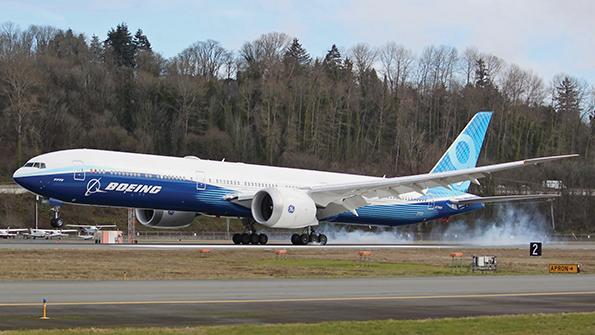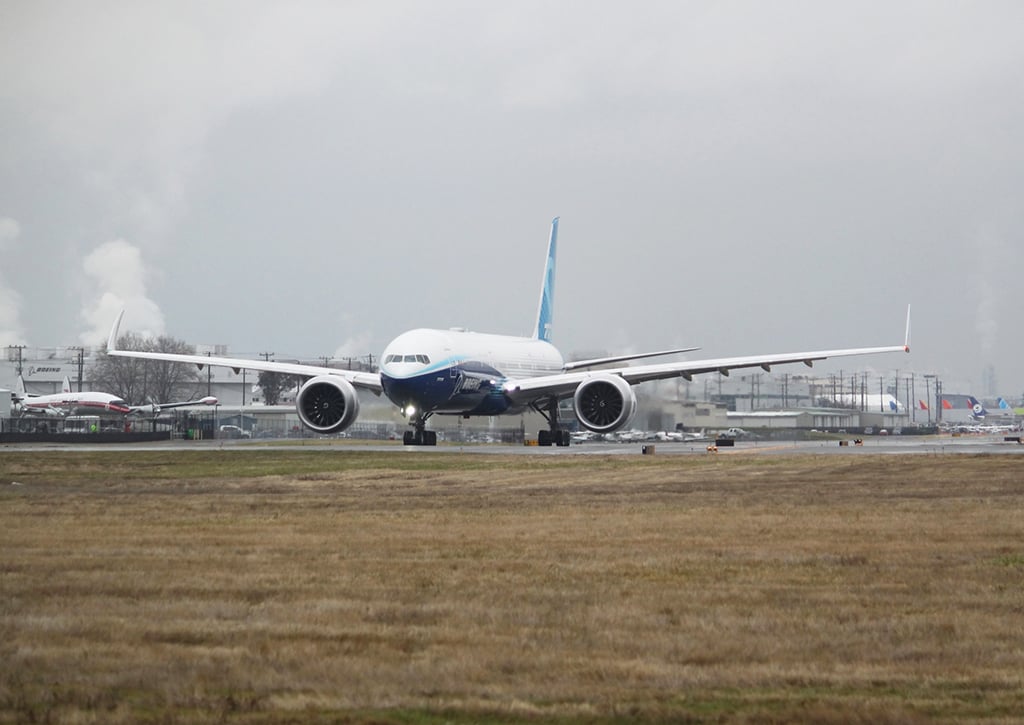
As the pace of flight testing picks up, Boeing’s first 777-9, WH001, and sister ship, WH002, will soon be rejoined by other test aircraft for the certification effort.
In late February, white smoke—the telltale sign of a big engine being fired up on wing for the first time—curled up from a Boeing 777-9 on the ramp at the company’s facility in Everett, Washington.
What makes this normally routine event significant is that the smoke came from the General Electric GE9X engines attached to “X-ray Yankee”—the third aircraft in Boeing’s 777X test fleet. Mothballed since last summer, Boeing spent February reactivating the big twin and lighting up a pair of newly installed engines, a major milestone toward returning it to flight.
- Third 777-9 test aircraft reactivated
- GE9X is a watch item for the delivery timetable
But from a bigger-picture perspective, is the revival of the 777-9, also known as WH003, a much-needed sign of new progress for the delayed program? The answer is almost certainly “yes.”
Most important, the European Union Aviation Safety Agency (EASA) and the U.S. manufacturer appear to have reached an understanding on common mode failure certification criteria for the large new twinjet, industry sources tell Aviation Week.
Although details of the compromise remain sparse, sources say EASA has given up its demands for fundamental flight control system changes to comply with its definition of redundancy. In return, Boeing has agreed to a protocol under which the system performance and any potential failures will be closely monitored for at least the first several years of 777X operations.
EASA did not initially reply to a request for comment. The agency’s executive director, Patrick Ky, recently confirmed that EASA was “converging” with Boeing on an agreement, without specifying any details. Boeing declined to comment and referred inquiries on the issue back to EASA.
An agreement between EASA and Boeing would be the first significant milestone on the way to finally delivering the first aircraft at the beginning of 2025, five years later than originally planned. But there are more hurdles: Boeing has yet to receive FAA Type Inspection Authorization (TIA), which would mark the beginning of certification flight testing. And in November, Boeing had to temporarily stop flight testing with another prototype after a component issue emerged on the GE9X.
“Much will now depend on the engine,” says Emirates Airline President Tim Clark.
The GE9X issue, which is thought to be concerned with the durability of the combustor liner, is being addressed by the engine-maker while flight tests continue with regular inspections. Boeing and GE are focused on a final root cause characterization of the issue to get a permanent solution tested and in place prior to deliveries.
The GE9X, which is the world’s most powerful turbofan and was certified in late 2020, has had previous development issues. In February 2018, the GE9X’s first flight on the company’s flying testbed was delayed by problems discovered in the high-pressure compressor variable stator vane lever arms. A redesign of the compressor stator subsequently delayed the 777-9 first flight by around six months to January 2020.
Progress on 777X certification is coming at just the right time, some assert, given that long-haul traffic demand has returned powerfully over the last year. During the coronavirus pandemic, many airlines retired their biggest long-haul aircraft, in particular the Airbus A380 and large numbers of Boeing 747-400s. Pessimists believed that long-haul flying might never come back to the previous levels, or at least for the foreseeable future.
This helped in creating a decent market for the smaller 787 and A350-900, while raising doubts about the viability of the 777X, which has around 50 more seats than the largest variant of the A350—the A350-1000. In Boeing’s standard two-class configuration, the 777-9 has 426 seats. Air Lease Corp. CEO John Plueger said last year that “one has to question a little bit the 777X program and its viability.”
But now, more optimistic voices are being heard. “By the time the aircraft is ready . . . the market should be recovered and healthy,” Melius Research Managing Director Rob Spingarn said in a recent Aviation Week Check 6 podcast. “It’s about 10% larger from a payload perspective than Airbus’ largest offering, the A350-1000, and we will have retired virtually all of the four-engine giants, the 747, the A380, those are going to be gone by then. . . . Some have come back just out of necessity because on trunk lines you need big airplanes, and the 777-8 and 777-9 are going to be the future’s big airplane, along with the A350-1000.”
Boeing has firm orders for 394 777Xs, including the 777-8F freighter. Emirates is by far the largest customer with 156 aircraft, followed by Qatar Airways (74). Other key customers include Singapore Airlines (31), Lufthansa (27), Cathay Pacific (21), All Nippon Airways (19), British Airways (18) and most recently Air India (10).
The Aviation Week Intelligence Network Commercial Fleet & MRO Forecast projects that Boeing will deliver 35 777-9s in 2025 and 65 each in 2026 and 2027. Deliveries of 777-8F aircraft start in 2027, with eight in total. Boeing will hand over 100 777Xs in 2030, including six of the smaller, currently shelved, 777-8 passenger variant, the data forecasts.
The Boeing-EASA agreement comes almost two years after the agency said that it would “increase its scrutiny on the flight control system on the 777X.” Commenting in February 2021, EASA added it would “be conducting a more in-depth review of the aircraft-critical changes as part of our lessons learned from the 737 MAX. We will be following a thorough process to ensure the safety of the aircraft.”
At the heart of the issue was a disagreement between Boeing and EASA over the vulnerability of the 777X flight control system to potential common mode failures caused by events such as lightning strikes, software errors, incorrect maintenance, explosions or electromagnetic interference.

EASA held that Boeing fly-by-wire systems, which traditionally employ triple-redundant architectures designed to survive two failures, were insufficiently protected. Instead, the agency backed the approach used in Airbus aircraft, such as the A320, which typically use five dissimilar computers running four dissimilar software packages.
The 777X flight control system and its supporting systems architecture is an evolution of the heritage 777 system with new elements added from the 787. Like the 787, but unlike the 777, the 777X fly-by-wire flight control system operates in all three axes (pitch, roll and yaw). The current 777 family uses the same pitch control law as the 787, but not the same roll control law—whereas the 777X will.
Boeing has insisted throughout that the long in-service safety and reliability record of the 777 and 787 flight control systems validates its design approach to the 777X. However, in response to EASA’s initial concerns, the company did change out some circuit cards and power supplies in the aircraft’s BAE Systems-developed integrated flight control electronics unit that includes the flight control computers and actuator control electronics.
News of the rework, and the resulting delay to the program—later extended to 2025—was revealed in early 2021 by Boeing CEO Dave Calhoun. Commenting at the time, Calhoun said: “We’ve made the decision to implement certain modifications to the aircraft design. Our decision to make these modifications, which will involve firmware and hardware changes to the actuator control electronics, reflects our current judgment of global regulators’ compliance expectations.” However, these moves alone were insufficient to appease EASA, and follow-on negotiations to arrive at the new compromise have been going on ever since.
The EASA/Boeing agreement is now expected to be fed back into the FAA, which plans to also make EASA’s requirements mandatory for a common certification basis. Meanwhile, the FAA is also believed to be edging toward approval for TIA—possibly near the end of the year—a move that will enable Boeing to begin flight testing for credit toward type certification.
The FAA’s decision to hold back TIA, in conjunction with EASA’s increased scrutiny on the flight control system and other 777X design aspects such as the folding wingtips, were driving factors behind Boeing’s decision to push back its initial delivery target to 2025. However, airline industry sources say that, following the EASA agreement, they are now increasingly confident that Boeing can meet its revised schedule for an entry-into-service date two years from now.
The second 777-9 test aircraft, WH002, was also recently reactivated and rejoined the flight program in February. The aircraft joined WH001, the first development 777-9, which itself resumed flying in late December following detection of the engine component problem by GE during ground tests in October.
TIA, when approved, will mark the start of certification testing with FAA pilots on board. TIA is only issued when the agency’s examination of the data required for type certification is completed or has reached a point where it appears that the aircraft will meet the applicable regulations. Preparing for TIA sometime in the next few months is not unreasonable, given the FAA’s own statements in 2021 that the aircraft’s amended type certificate was not likely to be awarded until mid-to-late 2023 at the earliest. Realizing the hurdles to be overcome, Boeing in 2022 itself slid the initial delivery target back to mid-2025.
Although FAA TIA is not dependent on EASA approval of the certification basis, in realistic terms the program needs international compliance across the board to progress. A satisfactory agreement with EASA would also pave the way toward a return to the standard bilateral convention between the U.S. and Europe, under which each regulator approves the validating authority’s certification without any technical involvement or approval by the other regulator.
Beyond the test and certification aspects, Boeing must also consider the timing of when to restart 777-9 production. This was paused early last year to focus on assembly of in-demand 777F freighters and to prevent the buildup of additional 777-9 inventory. Now, with the possibility of certification tests in the offing, and with it a firmer configuration, new production could likely begin later this year—albeit at a very slow rate—to support the delivery ramp in 2025.






